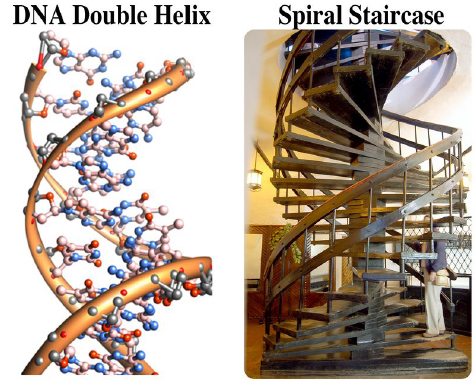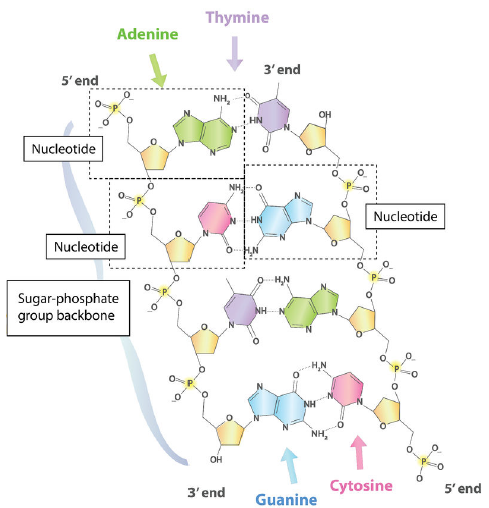Reading: The Double Helix
Douglas Wilkin, Ph.D.
http://www.ck12.org/saythanks
• Explain Watson and Crick’s double helix model of DNA.
How do sugars, phosphate groups and bases form DNA?
In an extremely elegant model, that’s how. The base-pairing rules tell us that A always pairs with T, and G always pairs with C. But how does all this information, all these nucleotides, form the molecule known as DNA? It took the work of four distinguished scientists, three distinguished gentlemen one under-appreciated legendary woman, to solve this mystery.
The Double Helix
In the early 1950s, Rosalind Franklin started working on understanding the structure of DNA fibers. Franklin, together with Maurice Wilkins, used her expertise in x-ray diffraction photographic techniques to analyze the structure of DNA. In February 1953, Francis Crick and James D.Watson of the Cavendish Laboratory in Cambridge University had started to build a model of DNA. Watson and Crick indirectly obtained Franklin’s DNA X-ray diffraction data demonstrating crucial information into the DNA structure. Francis Crick and James Watson then published their double helical model of DNA in Nature on April 25th, 1953.
DNA has the shape of a double helix, just like a spiral staircase ( Figure 1.2). As a nucleic acid, DNA is composed of nucleotide monomers, consisting of the deoxyribose sugar, a phosphate group, and a nitrogenous base (A, C, G or T). There are two sides to the double helix, called the sugar-phosphate backbone, as they are made from alternating phosphate groups and deoxyribose sugars. The “steps” of the double helix are made from the base pairs formed between the nitrogenous bases. The DNA double helix is held together by hydrogen bonds between the bases attached to the two strands.
FIGURE 1.2
The DNA double helix. The two sides are the sugar-phosphate backbones, composed of alternating phosphate groups and deoxyribose sugars. The nitrogenous bases face the center of the double helix. As the base-pairing rules tell us, A always pairs with T, and G always pairs with C.
Complementary Base Pairs
The double helical nature of DNA, together with the findings of Chargaff, demonstrated the base-pairing nature of the bases. Adenine always pairs with thymine, and guanine always pairs with cytosine ( Figure 1.3). Because of this complementary nature of DNA, the bases on one strand determine the bases on the other strand. These complementary base pairs explain why the amounts of guanine and cytosine are present in equal amounts, as are the amounts of adenine and thymine. Adenine and guanine are known as purines. These bases consist of two ring structures. Purines make up one of the two groups of nitrogenous bases. Thymine and cytosine are pyrimidines, which have just one ring structure. By having a purine always combine with a pyrimidine in the DNA double helix, the distance between the two sugar-phosphate backbones is constant, maintaining the uniform shape of the DNA molecule.
Anti-parallel Strands
The two strands in the DNA backbone run in "anti-parallel" directions to each other. That is, one of the DNA strands is built in the 5’ → 3’ direction, while the complementary strand is built in the 3’ → 5’ direction. In the DNA backbone, the sugars are joined together by phosphate groups that form bonds between the third and fifth carbon atoms of adjacent sugars. In a double helix, the direction of the nucleotides in one strand is opposite to their direction in the other strand. 5’ and 3’ each mark one end of a strand. A strand running in the 5’ → 3’ direction that has adenine will pair with base thymine on the complementary strand running in 3’ → 5’ direction.

FIGURE 1.3
The base-pairing nature of DNA. Adenine always pairs with thymine, and they are held together with two hydrogen bonds. The guanine-cytosine base pair is held together with three hydrogen bonds. Note that one sugar-phosphate backbone is in the 5’→3’ direction, with the other strand in the opposite 3’→5’ orientation. Notice that the 5’-end begins with a free (not attached to the sugar of another nucleotide) phosphate group, while the 3’-end has a free (not attached to the phosphate group of another nucleotide) deoxyribose sugar.
Four Letter Code
DNA is made of a four letter code, made of just As, Cs, Gs, and Ts, that determines what the organism will become and what it will look like. How can these four bases carry so much information? This information results from the order of these four bases in the chromosomes. This sequence carries the unique genetic information for each species and each individual. Humans have about 3,000,000,000 bits of this information in each cell; 3 billion bases in the genome. A gorilla may also have close to that amount of information, but a slightly different sequence. For example, the sequence 5’ AGGTTTACCAGT-3’ will have different information than 5’-CAAGGGATTACT-3’. The closer the evolutionary relationship is between two species, the more similar their DNA sequences will be. For example, the DNA sequences between two species of reptiles will be more similar than between a reptile and an elm tree.
DNA sequences can be used for scientific, medical, and forensic purposes. DNA sequences can be used to establish evolutionary relationships between species, to determine a person’s susceptibility to inherit or develop a certain disease, or to identify crime suspects or victims. Of course, DNA analysis can be used for other purposes as well. So why is DNA so useful for these purposes? It is useful because every cell in an organism has the same DNA sequence. For this to occur, each cell must have a mechanism to copy its entire DNA. How can so much information be exactly copied in such a small amount of time?
Vocabulary
• double helix: The double spiral shape of the DNA molecule; resembles a spiral staircase.
• genome: The complete set of an organism’s hereditary information; may be either DNA or, for many types of virus, RNA; includes both the genes and the non-coding sequences of the DNA/RNA.
• hydrogen bond: A weak bond between two molecules resulting from an electrostatic attraction between a proton in one molecule and an electronegative atom in the other; always involves a hydrogen atom.
• nucleotide: Monomer of nucleic acids, composed of a nitrogen-containing base, a five-carbon sugar, and a phosphate group.
• purine: Nitrogenous bases consisting of two ring structures; adenine and guanine.
• pyrimidine: Nitrogenous bases consisting of one ring structure; thymine and cytosine.
• sugar-phosphate backbone: The major structural component of the DNA molecule; formed of alternating deoxyribose sugars and phosphate groups joined by ester bonds.
Summary
• Watson and Crick demonstrated the double helix model of DNA.
• The two strands of the DNA double helix are complementary and run in anti-parallel directions.
Review
1. Explain Watson and Crick’s double helix model of DNA.
2. Explain why complementary base pairing is necessary to maintain the double helix shape of the DNA molecule.
3. In what direction do the two strands in the DNA backbone run to each other?
4. What is the four letter code?
